
 |
 |
 |
 |
 |
 |
 |
email: roadarch@outlook.com |
 |
| Welcome Arch Signs (page 1) |
(hit "refresh" to get the most recent version of this page; click on photos for larger images)
|
The photos and links at this page are meant to accompany an article that I wrote that I wrote for the Society for Commercial Archeology's Journal magazine.
The signs in this section are organized alphabetically by state. |
|
Alaska:
Welcome Arch: 1, 2 (Ketchikan) [map] |
| Welcome Arch Modesto, CA |
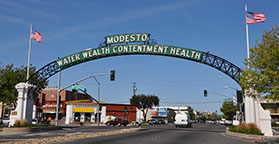 |
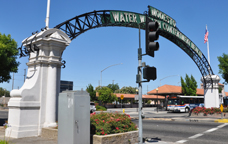 |
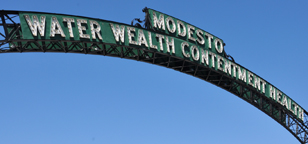 |
|
This Welcome Arch was built in 1912. It is 75 feet wide and spans I Street. It was designed by San Francisco architect, Bernard Joseph, for $2,500. The Modesto Arch is sometimes referred to as the Prosperity Arch. The slogan "Water Wealth Contentment Health" came from a contest. The winner was actually "Nobody's Got Modesto's Goat" but the City chose the second-place winner. Critics at the time developed their own slogan based on sign: "The land gets the water, the bankers get the wealth, the cows get contentment, and the farmers get the health."
The sign was lit with 348 incandescent bulbs on each side. There was originally a panel suspended beneath the sign which read "Welcome." But that was gone by the following year. In 1934, the arch was moved slightly for road widening. In the 1960s, there was a failed effort to remove the sign. It was restored in 2012 to celebrate its centennial. At that time, it was repainted the original green color and LED bulbs were installed. Flagpoles that were part of the original design were added. Those had been missing since the early 1950s. By the 1980s, two cypress trees were planted next to the sign to simulate those vertical elements. The trees were removed to create the original appearance during the restoration. It cost over $100,000 and was funded entirely through private donations. [map] |
| Welcome Arch Redwood City, CA |
Welcome sign Monte Rio, CA |
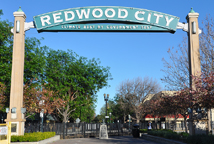 |
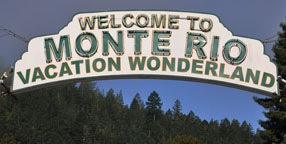 |
|
This Welcome Arch in Redwood City was originally installed in 1926. It was built by the Electric Products Company of San Francisco. The sign is 60 feet wide. The "Redwood City" letters were originally lit with bulbs. The "Climate Best By Government Test" came from a slogan contest in 1925. Around the same time, there was another nearly identical arch sign installed at the southern entrance to the city. Around 1940, both signs were modernized with neon. In the late 1940s, El Camino Real was widened and the signs were moved. In 1963, a new sign ordinance was passed and the southern arch was scrapped. In 1970, the northern arch was moved into storage and eventually scrapped as well. This replica sign was installed in the mid-1990s. For more, see this website. [map]
This Welcome sign in Monte Rio was installed in the late 1940s. It reads "Monte Rio Awaits Your Return" on the other side. There is no neon on that panel. In 2024, the sign was removed for restoration. The neon was removed and the tubing holes were patched. The sign was reinstalled on taller poles to avoid damage from trucks passing underneath. The city is now contemplating adding back the neon. For more, see this website. [map] |
| Welcome Arch Fresno, CA |
Welcome sign Fairfield, CA |
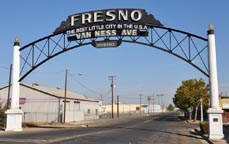 |
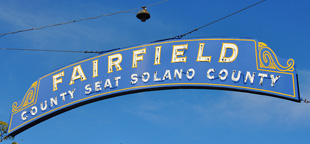 |
|
The original Welcome Arch in Fresno was built in 1917. It read "Entrance to Fresno Van Ness Boulevard." The letters were spotlit. There was a flagpole on top of each pillar. In 1925, that arch was damaged in a fire and demolished. This arch replaced it around 1929. Each column has a lit globe on top. It spans Van Ness Street which used to be the main route into town from the south. The sign was restored in 1980 and the panel reading "Best Little City in the U.S.A." added at that time. For more, see this website. [map]
This Fairfield Welcome sign spans the main street downtown. The first sign was a Federal Electric sectional bulb sign, installed in 1925. It was replaced with a neon sign in the early 1930s. The sign was removed in 1986 for restoration. The red light that had originally hung above the sign was located in storage and installed. That light was to signal police to call headquarters. The paint on the sign was not lasting. In 1989, the sign was removed again and the steel panels were replaced with aluminum versions. The sign was reinstalled in 1990. [map] |
| Welcome sign Pleasanton, CA |
 |
|
This Welcome sign was installed in 1932. In 1935, a siren and lights were added to the top of the sign for police use. They were used to notify the police and community about local emergencies. The siren was also used during World War II as an air raid warning system. For more, see this website. [map] |
| Bakersfield Arch Bakersfield, CA |
 |
| The Bakersfield Arch sign was originally built in 1949. It served as a footbridge between the Bakersfield Inn's main building and its new addition. By the late 1990s, the sign was in bad shape and the motel had closed. The sign was rebuilt in 1999 at its current location next to the Buck Owens Crystal Palace. Only the original letters could be saved. The project was funded by Buck Owens. For more, see these websites: 1 and 2. [map] |
| Broadway-Burlingame Arch Burlingame, CA |
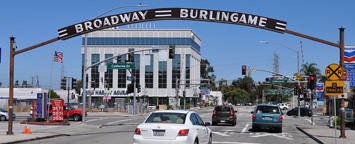 |
| This Broadway-Burlingame Arch was built in 1922 for the Pacific City amusement park in San Mateo, CA. The bulb letters originally read: "To Pacific City" and there was a lit arrow below it pointing in the directly of the park. The park closed in 1923. In 1927, the sign was moved to its present location and the lettering was changed to read "Broadway - Burlingame." The sign had Federal Electric porcelain enamel, sectional letters lit with bulbs. The arrow was kept. This photo is from 1930. Around 1937, the sign was restored and updated with neon. The sign was restored in 1988. [map] |
| Welcome Arch Castroville, CA |
|
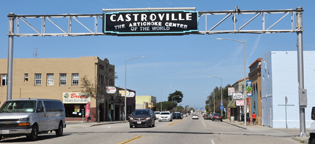 |
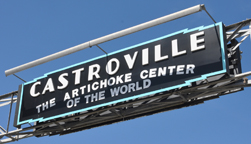 |
| This Welcome Arch was originally installed in 1931. It had neon then and there was a smaller sign above it reading "Artichoke Festival" with space to change the dates every year. In 1991, the sign was taken down for restoration. New stainless steel panels were created. I assume that's when the neon was removed and the overhead lighting was installed. These photos are from 2022. In 2025, the sign was removed and replaced with a different sign and supports. For more, see this website. [map] |
| Welcome sign Clovis, CA |
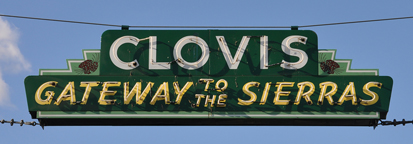 |
| The first Clovis Welcome sign was built from wood and installed in 1930. In 1946, it was replaced with a steel sign built by the Fresno Neon Sign Company. That sign was replaced with the current one in 1951. It is 13 feet wide. It was restored in 1992. For more, see this website. [map] |
| Lodi Arch Lodi, CA |
|
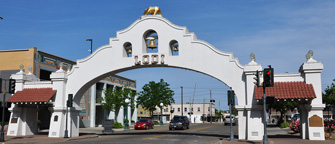 |
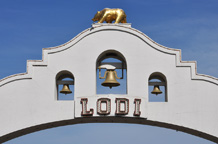 |
| The Lodi Arch was built in 1907 as an entrance for the Tokay Carnival. It is the oldest welcome sign in the country. The arch was restored in 1956. The bear, aka Archie, was built in 1909 with papier mache for parades in Stockton, CA. No one knows how it wound up in Lodi. It was rebuilt in 1938. It was restored in 2001. In 2023, the bear was restored again at Cherokee Auto Body. For more, see this website. [map] |
| Welcome Sign Encinitas, CA |
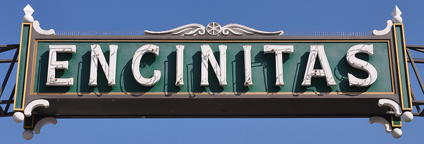 |
| This Welcome Sign was built in 2000. It is a close replica of the sign which was installed at this location in the late 1920s but had been missing for decades. This sign is bigger and required a much larger support structure. The road has been widened over time. For more, see this website. [map] |
| Welcome Arch Twain Harte, CA |
|
 |
 |
| The original Welcome Arch was built from logs but rotted and fell. In 1933, a second log arch was built. I don't know what the letters looked like then. By the mid-1940s, freestanding neon letters, secured with wire cables, were resting on the horizontal log supported by two log posts. By the mid-1950s, the letters were supported on a metal frame and the horizontal log was gone. The current arch was built in 1986. The hyphen was dropped from the letters then. The arch was damaged in 2002 and repaired. The neon has been missing from the letters for many years. For more, see these websites: 1 and 2. [map] |
|
More California:
Welcome sign (Ben Lomond) directional sign (Fowler) Welcome Arch (Orland) [map] Welcome sign (San Gabriel) Welcome sign (Santa Monica) Welcome Arch (Weed) [map] Welcome Arch (Williams) Yreka Arch (Yreka) |
|
Welcome Arch Signs page 2 |
Welcome Arch Signs page 3 |
Main SCA Article Companion Page |
Main Signs Page |
| RoadsideArchitecture.com |
Copyright. All photos at this website are copyrighted and may only be used with my consent. This includes posting them at Facebook, Pinterest, blogs, other websites, personal use, etc. Tips & Updates. If you have suggestions about places that I haven't covered, historical info, or updates about places/things that have been remodeled or removed, I'd love to hear from you: roadarch@outlook.com. |